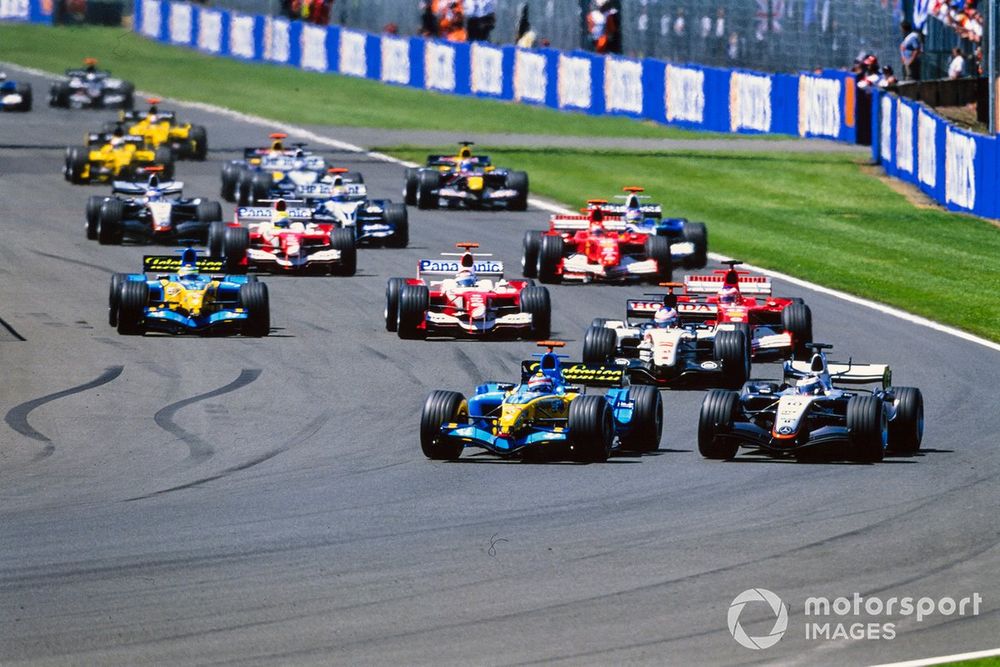FIA president Mohammed Ben Sulayem has suggested Formula 1 should consider a return to V10 engines running on sustainable fuels – but is the pitch worth considering?
F1 is switching to fully synthetic fuel next year as part of its engine overhaul, which will feature a near-50/50 split between a V6 internal combustion engine and a MGU-K electric motor, increasing the reliance on electric energy compared to the current powertrains.
Calls from some quarters about a return to V10s running sustainable fuels has emerged, but a high-profile propositioning from the FIA president brings the topic into a new spotlight. Our writers offer their views.
This is a ‘red meat’ exercise in courting popularity – Stuart Codling
During the death spasms of Boris Johnson’s time as British Prime Minister, his government embarked on a desperate series of policy announcements that were divisive and often outrageous, but were nevertheless calculated to appeal to his party’s base.
This was known internally as “Operation red meat”.
There is no other way to read FIA president Mohammed Ben Sulayem’s statement in which he spoke of considering “a range of directions including the roaring sound of the V10 on sustainable fuel”. The context of his missive was a response to the “positive discussion on the future of the sport” in the wake of this week’s F175 launch event at London’s O2 Arena.
This would be the same F175 event where the brief appearance of the FIA logo on screen triggered a round of booing so voluminous that it was only challenged by the crowd’s response to Red Bull team principal Christian Horner taking the stage. Ben Sulayem wasn’t in the room but several of his senior media functionaries were, so word of this outrage will have got back.
F1 75 show
Photo by: Getty Images
Ben Sulayem says “we must lead the way on future motorsport trends” but the V10 is anything but. It belongs in a rose-tinted vision of the past – one where Mars bars were bigger, Take That were still a five-piece, and health & safety didn’t rule the world so you could still climb in the bath with a toaster.
This isn’t to say that it isn’t desirable, or that it couldn’t be made to work. If sustainable fuels can be produced at scale for a reasonable cost, then there’s no reason in principle to not produce engines of whatever swept volume and with however many cylinders.
The question is: who would build these engines? Since the road car industry is fully set on course for electrification, it would be one hell of a pivot for any manufacturer to apply its badge to an internal combustion engine.
Of course, that assumes F1 needs road car manufacturers. There’s an argument to say it would be better for this category of motorsport to sever its ties with that industry, stay true to its roots, and rely on specialists such as Cosworth to produce bespoke internal combustion engines which could then carry whatever badge. After all, Red Bull briefly sailed with TAG Heuer on its engine covers.
Unless Ben Sulayem is envisioning a future without the road car manufacturers, then, we’re left with what this really is: a red-meat exercise to court popularity among the fan base.
There is sense to the idea as it could benefit F1 on multiple fronts – Alex Kalinauckas
Being in agreement with FIA president Mohammed Ben Sulayem is rather a rare position – although I think the underlying intention of the cack-handed clampdown on driver expression has some merit when it comes to trying to reduce abuse of officials. Here, though, he’s making sense.
The advancement of sustainable fuels has the potential to be game-changing for our burning planet. And so F1, its teams and manufacturers should and could play an exciting role in proving and improving the technology.

Start action, Fernando Alonso, Renault R25, Juan Pablo Montoya, McLaren MP4-20 Mercedes
Photo by: Motorsport Images
For fans, it’d be an additional win if the heavy hybrids can be abandoned. The noise of a screaming V10 is important to some, but getting back to the nimble cars of previous generations – a stated aim of the FIA even within the 2026 rule changes – alone could improve the spectacle more overall.
Imagine smaller cars, with drivers pushing flatout and racing closely amid the tweaked aerodynamics of the current era. Sure, work would be needed to ensure tyre degradation would play a part in overtaking, as it’s the only artificial method F1 has got to add excitement that works. But it has enticing potential.
This topic is going to keep cropping up as this season progresses and the rollout of the new fuels begins in earnest – with the oil companies backing teams seeking a competitive and PR edge for their products. So, why not lean into it?
It’s a popular idea with drivers ex and current, too. They inevitably want the greater thrill of flinging lighter machines around the world’s racetracks and if they get that they might just play a handy part in explaining why such technology can benefit more than just the extremely privileged.
So what if the manufacturers’ aren’t enthused right now? Its short-term thinking of big businesses that has so screwed things to this point. If there’s a way to satisfy all, then at least give it a go.
F1 will want its racing spectacle preserved – and I am against the constant rule changes of this era, as they mean just as things start to get interesting (late 2024 and this year) another rules reset will mean one team or manufacturer will pull clear and the others are left catching up. But, again, it’s a hit worth taking (once) that can eventually be overcome.
On this, F1 can have its cake and guiltlessly consume it too.
In this article
Autosport Staff
Formula 1
Be the first to know and subscribe for real-time news email updates on these topics
Subscribe to news alerts
Read the full article here

